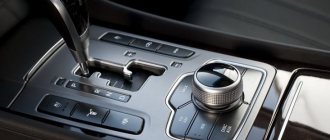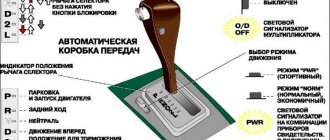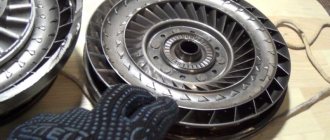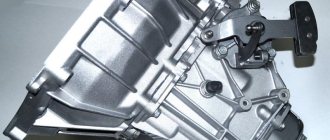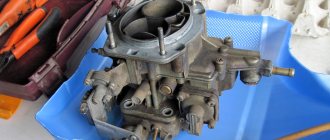The automatic transmission that is installed on modern cars is a rather complex unit. For this reason, its service life will directly depend on the quality of service.
Moreover, like any other device, an automatic transmission also has a strength limit, especially taking into account a number of design features. This means that the automatic transmission, depending on the degree of wear and condition, eventually begins to malfunction or fails.
At the same time, it is important to pay attention to certain signs that allow you to identify certain automatic transmission problems in time, after which you can carry out the necessary repair and restoration work at the lowest possible cost.
Car doesn't move when I release the brake
Clutches
How is rotation transmitted in an automatic transmission? To do this, a torque converter and clutch packs are used for each gear. If the car does not move forward without gas, but moves backward, then most likely the clutches responsible for first gear are slipping. The same thing happens that happens when the clutch slips. It is important to note that such slipping does not allow us to move off abruptly, since some time will pass from the moment we apply gas to the moment the car starts moving. This indicates that the clutches are failing.
The second moment is when a car with an automatic transmission does not move forward or backward until we press the gas. In this case, the problem may also be in other clutches. In addition, the problem can also be found in the torque converter, although its slipping occurs less frequently.
Why do clutches slip? This happens due to improper operation of a car with an automatic transmission. The instructions indicate that you cannot skid on it, but drivers stuck in mud or snow will skid, which will kill the box. This is especially true for modern-made machines. Now the clutches are not as powerful as before, and the gearbox may require repairs after 100 thousand kilometers.
Torque converter
If the car does not move in any direction at all and does not even shift, then the problem lies in the torque converter. The latter provides communication between the gearbox and the engine. Works together with the clutch.
Correction instructions
An automatic transmission is a complex device both in operating principle and in design. Therefore, its repair is labor-intensive and complicated. Repair work should be carried out with special knowledge, tools, equipped premises and assistants.
What will you need?
When repairing automatic transmissions, you must use only special tools. If you use conventional tools, there is a high probability of damage to parts of the machine box. Using the necessary tools speeds up repairs and improves the quality of work performed. Automatic transmission repair tools are used depending on its design:
- oil pump puller for mounting/dismantling the pump in a 4-speed automatic transmission;
- a special mandrel is used to install the differential oil seal;
- The flange head is used to unscrew the flange head of the shank;
- tool for collecting and disassembling boosters;
- a toothed wrench is designed for mounting/dismounting a toothed flange mounting nut;
- a set of mandrels - devices for removing bearings;
- lip frame for installing drive shaft oil seals;
- installation tool for installing the planetary gear set;
- oil pump mandrel;
- kit for installing pistons, etc.
The above lists only a small part of the tools used when repairing automatic transmissions. Depending on the type of automatic transmission, you must purchase the appropriate tools.
Steps
It should be remembered that the automatic transmission is located at the bottom of the car. Before getting to the box you will have to disassemble part of the car. However, this is difficult to do without special devices. Reassembly will require care. A large number of electronics in modern cars require precise adjustment. Therefore, it is better to disassemble an automatic transmission if you have complete confidence in your own abilities, otherwise it is better to contact a service center.
Loading …
To dismantle the automatic transmission, a platform, inspection hole or hydraulic lift is required. Before disassembling the automatic transmission, it should be washed from the outside, this will prevent dirt from entering the internal parts. The workplace must also be kept clean.
Removing the automatic transmission
The variety of automatic transmissions requires studying their dismantling instructions, since each has its own characteristics during disassembly. Dismantling begins by disconnecting all pipes. The procedure should be performed carefully so as not to damage the fitting. Then disconnect the electrical wiring, lines and cables. Then the engine flywheel membrane and torque converter are dismantled. In some gearbox models, the starter must be removed before removing the gas turbine engine.
Repair of a gas turbine engine consists of disassembling it, detecting faults and replacing worn parts. To disassemble the torque converter, the weld seam is cut off. After repair, the housing is welded again and its tightness and the presence of a thermal gap inside are checked. The work must be performed by a qualified person using appropriate equipment.
Automatic transmission torque converter
The control unit must be checked, which may break due to overvoltage, overheating, or mechanical damage. It is located on the hydraulic block and is constantly in oil - an aggressive environment. The control unit consists of an integrated circuit with many connectors and wires supplied and is housed in a plastic, non-separable housing.
Often the cause of the malfunction is a broken conductor on the contact pad of the control unit. If it is necessary to get to the integrated circuit, the body is cut with a special cutter. Damage is then determined through external examination and diagnosis. After the connection is restored, the wires are coated with an anti-corrosion agent and a special gel. After repair, the housing is sealed again.
If slipping or shocks occur when changing gears, then repair of the automatic transmission valve body is necessary. This work requires special cleanliness and care. Each part should be thoroughly washed and dried. If the valve is heavily soiled, it is better to replace it, since flushing will not provide the necessary reliability. If they are not very dirty, then each part of the valves should be thoroughly inspected and cleaned.
It is necessary to check the plungers; they should not be scratched or damaged, as this may cause the valve to jam. The plungers should slide freely over the valve openings.
After all repair work has been carried out, the automatic transmission is installed in place. In this case, you should adhere to the following recommendations:
- Before installing the gearbox back, it is necessary to check the membrane with an indicator head for the presence of end runout; if it is present, the membrane should be replaced. The radiator, lines, and all surfaces of the automatic transmission must be thoroughly cleaned before installation.
- Flushing the radiator should be done until the gasoline is clean. Then a liter of transmission fluid is poured into the gas turbine engine and securely installed on the input shaft. A complete fit and a secure connection must be achieved.
- The engine is mated to the automatic transmission along guide pins - the crankcases must be completely adjacent.
- The box is screwed on and the absence of gaps is checked. When connecting lines, it is necessary to check the correct connection.
- At the last stage, pour oil into the gearbox and check its performance at low engine speeds.
Filling transmission oil into the automatic transmission
When dismantling and installing the gearbox, you should be especially careful. If the work is being carried out for the first time, then you need to carefully study the instructions and it is advisable to write down the sequence of actions. The subsequent operation of the automatic transmission will depend on the quality of the work performed.
If you decide to repair an automatic transmission yourself, you should remember about compulsory insurance. The insurance is valid if the car is in good technical condition; repairs and maintenance must be carried out by a car service center. Do-it-yourself repairs may void insurance guarantees.
On the back goes forward
If you think logically, then incorrect actions occur in the box. If, instead of going forward, the car goes backwards, it means that it is reverse gear, and not first.
In general, such a problem almost never appears on a box that has never been disassembled. In most cases, the problem lies in improper assembly of the automatic transmission. But there are also errors in the program. After all, modern machines are controlled electronically. It may be worth replacing the automatic transmission control unit or checking how the valve body was assembled after repair.
Automatic transmission diagnostics
Automatic gearbox: 1 — band brake; 2 — planetary mechanism; 3, 4, 12 and 13 - multi-disc clutches; 5 - oil pump; 6 — torque converter; 7 — input shaft; 8 — intermediate gear; 9 — differential; 10 - gear; 11 — freewheel
What is the diagnosis of the transmission system? Every 10,000-15,000 km, the car should be sent to a specialized maintenance station, where the main components of the engine compartment, chassis, etc. are checked using special equipment.
The vehicle needs a full inspection if there is a deterioration in control. In particular, the power has dropped or the dynamics have noticeably deteriorated. Bearings are checked if there is noise immediately after the engine has been started.
There should be no damage to the plunger. Otherwise, the motorist may encounter a problem such as a jammed valve. If the vehicle does not move when changing forward gears, check the piston cuffs in the forward clutch.
In order not to cause damage to the transmission system or engine, it is recommended to trust the transmission restoration work to professionals. Specialized service technicians must check the condition of the friction discs, torque converter and other components related to the automatic transmission type.
Thus, the proper operation of the gearbox depends on the efficiency of the motor. It is important to carry out diagnostic procedures for the vehicle in a timely manner so that serious problems associated with the gearbox do not arise later, for example, the automatic transmission only goes backwards. In addition, not every service is ready to undertake major repairs. Checking the box begins with visual diagnostics, followed by its dismantling from its original location, followed by disassembly and replacement of worn components.
How to avoid these breakdowns?
Only important and most important rules of operation and maintenance will help keep the box alive. It is important to promptly change the oil in your automatic transmission every 60 thousand kilometers. In addition, we must not forget that the automatic transmission does not like heavy loads and it is impossible to overheat it off-road.
It is important to consider that a properly maintained automatic transmission can last up to 300 thousand kilometers. If the car has already passed this mileage threshold, and malfunctions occur during operation, it is necessary to carry out a major overhaul of the gearbox.
Most common faults
The main malfunctions that may occur during long-term operation of the vehicle:
- whistling sound;
- there is a characteristic noise when the power plant starts up;
- The automatic transmission does not engage when turned on;
- the car stalls when changing gears;
- the appearance of a specific smell from the selector;
- extraneous knocking noises when changing gears.
A whistling sound may be due to a torque converter problem. Also, you should pay attention to the fuel level in the box. Oil starvation leads to damage to the oil pump gears. If the pumping device fails, it will become impossible for the calipers to move, and extraneous sounds will appear from the gearshift lever.
The valve body ensures redistribution of transmission oil flows and pressure. Slips and impacts are the main signs that the automatic transmission valve body is broken. The valve needs to be flushed if it is dirty.
Possible options for why the hydraulic unit does not work:
- clogging of channels and valves with wear products;
- valve winding break;
- wear of the valve working surface.
It is unacceptable to drive a vehicle if there is a clanging sound from the side of the gearbox when the power plant is idling. It is necessary to check the integrity of the friction clutch discs. This spare part is responsible for blocking the elements of the planetary mechanism.
Automatic transmission repair is necessary if the integrity of the sealing gaskets has been compromised, which may result in oil leaks.
Any automatic transmission repair and restoration work should be carried out using appropriate tools. In particular, a set of heads, mandrels, wrenches, installation tools, etc. is required. Assembling and disassembling the box requires maximum care and precision.
Air-fuel mixture
Let me remind you a little about the principle of the internal combustion engine (ICE). Many of the “newbies” think that it runs “purely on gasoline” and that nothing else gets inside the cylinders. BUT this is not true at all. Gasoline is of course an important component, but it will not burn without oxygen, so air (which contains some oxygen) is also supplied inside through the intake manifold.
Thus, an air-fuel mixture is prepared, this is gasoline + air. Either in the intake manifold, or directly in the engine cylinders.
It is this that burns inside, forcing the pistons to move, and they, in turn (through the connecting rods), rotate the crankshaft - work happens.
Why is it difficult for the gear lever to shift on a manual transmission?
- It is advisable to move in the gear that corresponds to a given speed, this relieves both the engine and the gearbox from unnecessary loads, the best is 4th gear, also called “direct”, in this connection the minimum number of gears and all two shafts are occupied (in bypassing the intermediate). This reduces wear on the manual transmission
- A lower gear should be engaged when the speed decreases, just like an upshift when accelerating.
The main causes of malfunctions Mechanics, like automatic ones, are designed to transmit and change torque from the power unit to the wheels, and this must be done comfortably and dynamically. That is, the car must accelerate as quickly as possible and do this without any “jerks” of prohibitive engine speeds (so that it does not “growl like a victim”) and, if possible, have sufficient traction forces.

